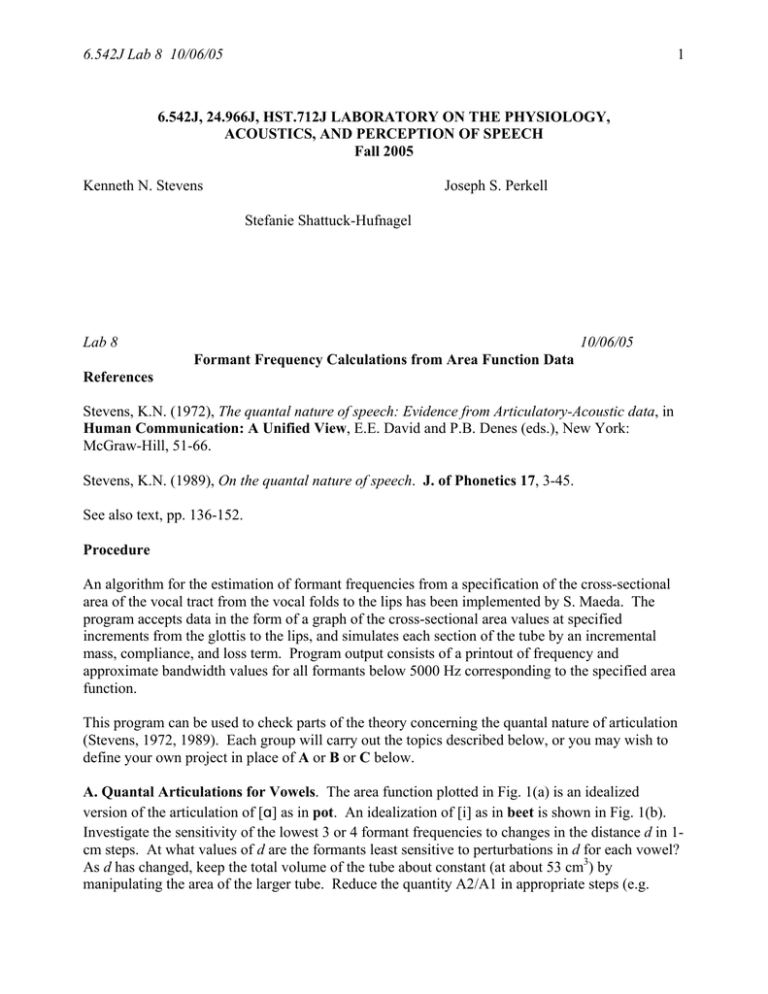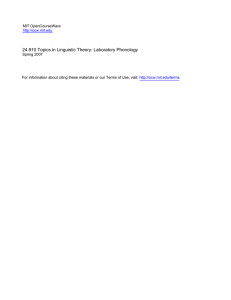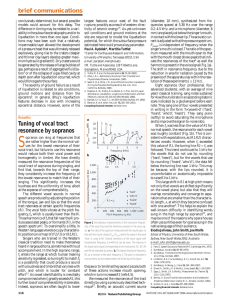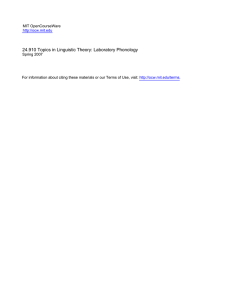6.542J Lab 8 10/06/05 Lab 8 10/06/05 1
advertisement

6.542J Lab 8 10/06/05 1 6.542J, 24.966J, HST.712J LABORATORY ON THE PHYSIOLOGY, ACOUSTICS, AND PERCEPTION OF SPEECH Fall 2005 Kenneth N. Stevens Joseph S. Perkell Stefanie Shattuck-Hufnagel Lab 8 10/06/05 Formant Frequency Calculations from Area Function Data References Stevens, K.N. (1972), The quantal nature of speech: Evidence from Articulatory-Acoustic data, in Human Communication: A Unified View, E.E. David and P.B. Denes (eds.), New York: McGraw-Hill, 51-66. Stevens, K.N. (1989), On the quantal nature of speech. J. of Phonetics 17, 3-45. See also text, pp. 136-152. Procedure An algorithm for the estimation of formant frequencies from a specification of the cross-sectional area of the vocal tract from the vocal folds to the lips has been implemented by S. Maeda. The program accepts data in the form of a graph of the cross-sectional area values at specified increments from the glottis to the lips, and simulates each section of the tube by an incremental mass, compliance, and loss term. Program output consists of a printout of frequency and approximate bandwidth values for all formants below 5000 Hz corresponding to the specified area function. This program can be used to check parts of the theory concerning the quantal nature of articulation (Stevens, 1972, 1989). Each group will carry out the topics described below, or you may wish to define your own project in place of A or B or C below. A. Quantal Articulations for Vowels. The area function plotted in Fig. 1(a) is an idealized version of the articulation of [] as in pot. An idealization of [i] as in beet is shown in Fig. 1(b). Investigate the sensitivity of the lowest 3 or 4 formant frequencies to changes in the distance d in 1cm steps. At what values of d are the formants least sensitive to perturbations in d for each vowel? As d has changed, keep the total volume of the tube about constant (at about 53 cm3) by manipulating the area of the larger tube. Reduce the quantity A2/A1 in appropriate steps (e.g. 6.542J Lab 8 10/06/05 2 times 0.6, again keeping the volume constant) to determine the point at which formants begin shifting more rapidly to positions appropriate for the neutral vowel (uniform vocal tract). If time permits, assess the effect on the formants (for one of the configurations) as the lips are rounded. Rounding can be simulated by decreasing the cross-sectional area of the 1-cm section at the lip end of the vocal tract. B. Quantal Places of Articulation for Consonants. During the production of a fricative consonant, the vocal tract assumes a configuration that is idealized in Fig. 2. The position of the constriction is given by the variable d. Plot the loci of the lowest 5 formants as d is varied from 12 cm (appropriate for the Arabic pharyngeal consonants) to 2 cm (typical of the English /s/) in 1 cm or 0.5 cm steps. Identify the front cavity resonances from your plot, and indicate the quasistable regions (quantal places of articulation a la Stevens). If time permits, observe the effect of closing the lips for the configuration corresponding to /s/, with d = 2 cm. Closing the lips can be simulated by reducing the cross-sectional area of the 0.5 cm section at the front end of the vocal tract from 3 cm2 to a small area like 0.2 cm2 in logarithmically spaced steps. How does the front-cavity resonance change as the lips close? Is this change predictable from acoustic theory? C. Subglottal Resonances and their Potential Role in Shaping the Front-Back Distinction for Vowels. There are resonances of the subglottal system at frequencies of about (1) 500-700 Hz (2) 1400-1800 Hz, and (3) 2000-2300 Hz. We concentrate here on the second resonance. It has been hypothesized that this subglottal resonance creates a dividing line between front vowels (F2 above this resonance) and back vowels (F2 below this resonance). If F2 for a vowel were placed close to this resonance, the spectrum peak corresponding to F2 would be shifted so that it would “avoid” being close to the subglottal resonance. (Acoustic theory of coupled resonators supports this view.) Thus the vowels in a language may be adjusted to avoid this region, and this frequency region can then be regarded as a “quantal” influence that defines the front-back boundary for vowels. In this part of the lab, you will examine this effect. Stored under lab08 in your group’s directory you will find several versions of the words beat and buy. (These are taken from the original readings from Lab 1 for several speakers.) In the word beat, F1 and F2 are always well separated from the second subglottal resonance. In the spectrum of the vowel for most if not all of the versions of this word, you should see a small peak in the frequency range 1400-1800 Hz. This peak is evidence for the second subglottal resonance. Measure the frequency of this peak. Also measure its amplitude relative to the peak corresponding to F1 (i.e. the difference in dB). In the word buy, F2 should rise from a low value in the initial part to a higher value (above 14001800 Hz) in the final part. You may see a rather abrupt jump in frequency and amplitude as F2 passes through this region. The effect can be viewed on the spectrogram and on successive versions of the spectrum sampled 10 milliseconds apart (press F or B on xkl). Is this discontinuity in the range of F2 measured above for beat? Try to quantify the magnitude of the jump in F2 and its amplitude in buy. 6.542J Lab 8 10/06/05 To use the vtcalcs program In the labc account, move to the vtcalcs_2002 directory and type matlab. In the MATLAB command window, type vtcalcs. Click on VT calculation For part A of lab, click on 2 tube model. The three windows will display the tube shape, the calculated transfer function, and the formant frequencies and bandwidths. Change parameters by clicking on right panel. New calculations are made. Click on synthesize to listen to steady-state vowel. To construct a more complex area function (as in part B of lab), click on area functions model. Modify area function by manipulating parameters in right panel. Various constants associated with the tube are listed in tract configuration and physical constants. 3 6.542J Lab 8 10/06/05 4






